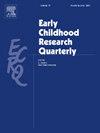An initial yet rigorous test of multisensory alphabet instruction for english monolingual and emergent bilingual children
IF 3.1
1区 教育学
Q1 EDUCATION & EDUCATIONAL RESEARCH
引用次数: 0
Abstract
Little evidence exists on how best to support children’s alphabet knowledge, which is a foundational early literacy skill. In this study, we investigated the impact of multisensory alphabet instruction on the alphabet learning of English monolingual and emergent bilingual (EB) children aged 3:5 to 5 years old, compared to visual-auditory alphabet instruction (i.e., featuring visual and auditory modalities, which are typically present in alphabet instruction). We also investigated whether children’s language status, either EB or not EB, moderated the impact of multisensory alphabet instruction. We utilize a rigorous within-subjects experimental research design. Thirty-six children were enrolled in the study and received 1:1 alphabet instruction on two sets of four letters, either using a multisensory or visual-auditory approach, with a final set of four letters as a control. Findings revealed that young children benefited from explicit and systematic alphabet instruction, whether multisensory or visual-auditory, in terms of improving their lowercase letter knowledge. EB and English monolingual children experienced a similar benefit from alphabet instruction, perhaps because they had similar socio-economic status and language backgrounds. In using an experimental design and strong counterfactual, this study contributes to the literature concerning understanding effective evidence-based practices to promote English monolingual and EB children’s alphabet knowledge.
一项针对英语单语和紧急双语儿童的多感官字母教学的初步而严格的测试
很少有证据表明如何最好地支持儿童的字母知识,这是一项基本的早期识字技能。在这项研究中,我们研究了多感官字母教学对3 - 5岁英语单语和紧急双语儿童字母学习的影响,并与视觉-听觉字母教学(即以视觉和听觉方式为特征,这是字母教学中典型的表现)进行了比较。我们还调查了儿童的语言状况是否会调节多感官字母教学的影响。我们采用严格的学科内实验研究设计。36名儿童参加了这项研究,并接受了两组四个字母的1:1字母教学,使用多感官或视觉听觉方法,最后一组四个字母作为对照。研究结果显示,幼儿受益于明确和系统的字母教学,无论是多感官还是视觉听觉,在提高他们的小写字母知识方面。EB和英语单语儿童从字母教学中获得了类似的好处,也许是因为他们有相似的社会经济地位和语言背景。本研究采用实验设计和强大的反事实,有助于理解有效的循证实践,以促进英语单语和EB儿童的字母知识。
本文章由计算机程序翻译,如有差异,请以英文原文为准。
求助全文
约1分钟内获得全文
求助全文
来源期刊

Early Childhood Research Quarterly
Multiple-
CiteScore
7.00
自引率
8.10%
发文量
109
期刊介绍:
For over twenty years, Early Childhood Research Quarterly (ECRQ) has influenced the field of early childhood education and development through the publication of empirical research that meets the highest standards of scholarly and practical significance. ECRQ publishes predominantly empirical research (quantitative or qualitative methods) on issues of interest to early childhood development, theory, and educational practice (Birth through 8 years of age). The journal also occasionally publishes practitioner and/or policy perspectives, book reviews, and significant reviews of research. As an applied journal, we are interested in work that has social, policy, and educational relevance and implications and work that strengthens links between research and practice.
 求助内容:
求助内容: 应助结果提醒方式:
应助结果提醒方式:


